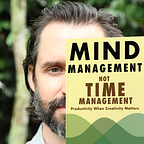Creativity, Fast & Slow
Making creative work happen is mysterious and seemingly random. Sometimes the right idea comes to you in an instant. Other times you’re in agony staring at the blank canvas.
Creative work becomes less mysterious when you look at it this way: There’s fast creativity, and there’s slow creativity.
Behavioral scientist Daniel Kahneman wrote the book Thinking, Fast & Slow. He says there’s fast thinking: the snap judgements we make. There’s also slow thinking: more effortful and rational thinking. Sometimes these modes are in conflict.
Fast creativity and slow creativity are often in conflict, too.
Fast creativity counts on the stuff that you already know. If I ask you to write 100 words describing your best friend, it would be relatively easy.
But if I asked you to write 100 words on how a refrigerator works, it might be hard. Even if you have access to the Internet, it may take you awhile to learn enough to put it in your own words.
Which is to say, writing about your best friend would be fast creativity. Writing about how a refrigerator works would be slow creativity.
Practicing slow creativity builds fast creativity. Creative insights come from connecting disparate elements. The more elements you have available to connect, the better your chances of coming up with a solution.
When you’re creating something, you’re using your working memory. Your working memory is connecting things from your long-term memory.
Your working memory can hold about four things at a time. Your long-term memory can hold limitless things.
This is why it’s harder to write 100 words on how a refrigerator works. You have to juggle all of the things you just read on Wikipedia about how a refrigerator works. You’re trying to hold all of those things in your working memory, while trying to compose your writing.
The ease of these two tasks depends on what you already know— what you already have in your long-term memory. If you are a professional writer, both tasks will be relatively easy. The processes of writing and of parsing new knowledge into prose have become fast creativity for you. If you’re a refrigerator-repair technician, writing about how a refrigerator works will also be easier.
I discovered the conflict between fast creativity and slow creativity when I was writing my first book. I had been doing creative projects as a designer for so long, design had become fast creativity for me.
I could plan out a design project, and execute it. I could meet a deadline. After all, design was such fast creativity for me, I was writing a book about it.
But I wasn’t an experienced writer. Writing was still slow creativity for me. I tried to plan my project and progress, but my estimates were wildly inaccurate.
To meet my deadlines, I had to cut out everything in my life. My creative output was too unpredictable to risk failure. I’d bang my head against the wall for twelve hours a day. Seemingly at random, I’d hit “flow,” and I’d do a whole day’s writing in fifteen minutes.
I got better at writing when I thought of it in terms of fast creativity and slow creativity. I dedicated some time to fast creativity, and I dedicated some time to slow creativity.
Fast creativity was writing what I knew. I’d write prose or an outline, or edit what I’d written earlier.
Slow creativity was writing what I didn’t know. I might be researching, or I might be trying to work on new skills like sentence structure, or storytelling.
During fast creativity sessions, I’d identify work to be done in my slow creativity sessions. If something needed to be researched I’d put it [in brackets]. I’d research the thing in brackets during slow creativity sessions.
Next time you’re feeling creatively stuck, ask yourself: Is slow creativity holding back my fast creativity? Work in one mode at a time. Your creative work will go more smoothly, and what is slow creativity today will become fast creativity tomorrow.
I quadrupled my creative productivity. Sign up and I’ll send you the tools I count on »
